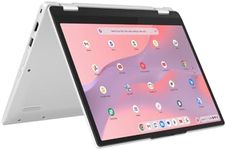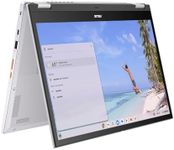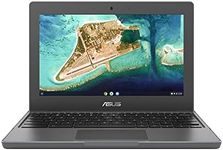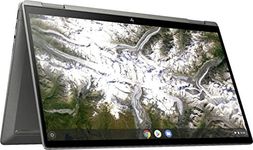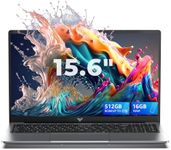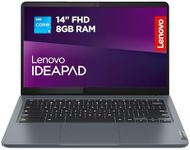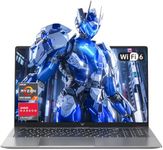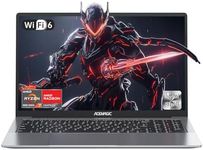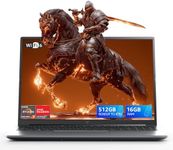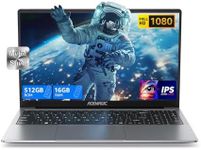Buying Guide for the Best Touchscreen Chromebooks
When choosing a touchscreen Chromebook, it's important to consider how you'll be using the device. Chromebooks are known for their simplicity, speed, and integration with Google services, making them ideal for students, professionals, and casual users who primarily work online. The touchscreen feature adds an extra layer of interactivity, which can be particularly useful for tasks like drawing, note-taking, or simply navigating the interface more intuitively. To find the best fit for your needs, you'll want to look at several key specifications that can affect your overall experience.Screen SizeScreen size is the diagonal measurement of the display, typically measured in inches. It determines how much space you have for viewing content and how portable the device is. Smaller screens, around 11 to 12 inches, are more portable and easier to carry around, making them ideal for students or frequent travelers. Medium-sized screens, around 13 to 14 inches, offer a balance between portability and viewing comfort, suitable for general use. Larger screens, 15 inches and above, provide more space for multitasking and are better for media consumption or productivity tasks, but they are less portable. Consider how you plan to use your Chromebook and where you'll be using it most often to decide on the right screen size for you.
ResolutionResolution refers to the number of pixels on the screen, which affects the clarity and detail of the display. Common resolutions include HD (1366x768), Full HD (1920x1080), and higher. HD resolution is sufficient for basic tasks and smaller screens, but if you plan to watch videos, edit photos, or use the device for extended periods, a Full HD resolution will provide a sharper and more enjoyable viewing experience. Higher resolutions are available and offer even more detail, but they may also consume more power and are typically found on larger screens. Choose a resolution that matches your usage habits and visual preferences.
ProcessorThe processor, or CPU, is the brain of your Chromebook, determining how quickly it can perform tasks. Chromebooks often use Intel or ARM processors. Entry-level processors, like Intel Celeron or ARM-based chips, are suitable for basic tasks like web browsing and document editing. Mid-range processors, such as Intel Pentium or Core i3, offer better performance for multitasking and more demanding applications. High-end processors, like Intel Core i5 or i7, provide the best performance for intensive tasks like video editing or running multiple applications simultaneously. Consider what tasks you'll be performing most often to choose a processor that meets your needs.
RAMRAM, or Random Access Memory, is crucial for multitasking and running applications smoothly. It temporarily stores data that your Chromebook is actively using, allowing for quick access. Chromebooks typically come with 4GB, 8GB, or more RAM. 4GB is adequate for basic tasks and light multitasking, such as browsing the web and using Google Docs. 8GB is better for more intensive multitasking, such as running multiple tabs or applications simultaneously. More than 8GB is generally only necessary for very demanding tasks or future-proofing your device. Consider how many applications you use at once and how you use your Chromebook to determine the right amount of RAM.
StorageStorage capacity determines how much data you can keep on your Chromebook, including apps, files, and media. Chromebooks often come with 32GB, 64GB, or 128GB of storage, as they are designed to work with cloud storage solutions like Google Drive. 32GB is sufficient if you primarily use cloud storage and don't need to store many files locally. 64GB offers more flexibility for storing apps and some files offline. 128GB or more is useful if you plan to store a lot of media or work offline frequently. Consider your storage habits and whether you prefer to keep files locally or in the cloud when choosing storage capacity.
Battery LifeBattery life indicates how long your Chromebook can run on a single charge, which is important for portability and convenience. Chromebooks are known for their efficient power usage, often providing between 8 to 12 hours of battery life. If you plan to use your Chromebook on the go, such as for school or travel, longer battery life is beneficial to avoid frequent charging. If you'll mostly use it at home or near a power source, battery life may be less critical. Consider your daily routine and how often you'll have access to charging to determine the necessary battery life for your needs.
Build Quality and DesignBuild quality and design affect the durability and aesthetic appeal of your Chromebook. Some models are made with plastic, which is lightweight and affordable, while others use metal or aluminum for a more premium feel and increased durability. Consider whether you need a rugged design for frequent travel or a sleek design for professional settings. Additionally, look for features like a 360-degree hinge if you want a convertible Chromebook that can be used as a tablet. Think about where and how you'll use your Chromebook to decide on the right build quality and design for you.




